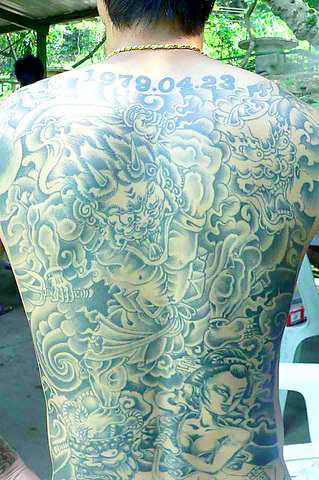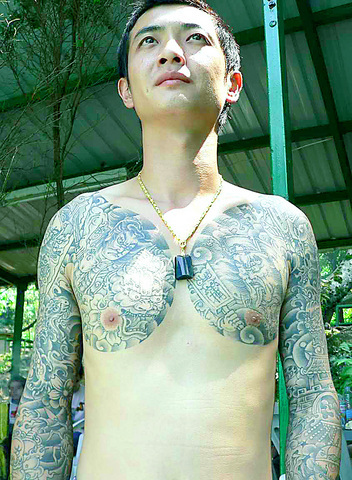Interactive art takes on a whole new meaning this weekend, as Taipei hosts only its second ever Taiwanese Tattoo Convention, in the Xinyi district near the Warner Village complex, outside New York New York department store.
Activities start tomorrow around 10am with a break-dancing competition. During regular intervals in the competition, the crowd will be treated to a cat-walk show of tattooed models. Expect to see quality work by local artists and, in particular, full-body tattoos of Daoist mythological gods and demons perfectly sculpted around muscles that in their movements make legendary battles seem vividly alive. "Life is art," the adage goes and there can be no better way to express such an ideal and to celebrate the human form.
For the rest of the day, until 8pm, the buzz of the tattoo gun will fill the air as a team of a dozen tattoo masters will be offering their services to anyone who decides to get inked. The convention will undoubtedly draw a larger crowd on Sunday and proceedings are set to start at 10am again with a similar line up to the day before.

PHOTO NICK WHEELER, TAIPEI TIMES
Since dynastic China, tattoos have been seen as the badge of criminal fraternities, so there is no surprise that in modern Taiwan, as in Japan, people with tattoos are still viewed in a negative light by a large segment of society. One of the principle organizers of the event Tsai Jong-da (
Two weeks ago in his studio, Tsai explained the importance of the quality of the inks used by tattooists. He uses either British or US products and, in the unlikely event that the colors should fade after only a few years, free touch-ups are provided. He then continued by saying a full back piece would cost a few hundred thousand NT$, as heavily shaded work demands a greater degree of attention and is extremely time consuming, not to mention energy draining for both customer and artist.
Books full of various images will be available at the convention for those unable to come up with an original design, but most people that choose to be tattooed spend time tailor-making something that is meaningful to them. All tattoo artists present will be more than happy to discuss ideas with the initiated and first-timer alike.

Foreign tattoo enthusiast Andrew Braddock says, "If you are going to be marked forever, you have to think very seriously about something that represents you in a timeless sense." He also said that art should be as alive as possible and should always be fluid, ever-changing and never stagnant, just like the human body; hence he thought of tattooing as one of the highest forms of art. He concluded his interesting theory by drawing a comparison between tattooed people and martial artists: "Martial artists have overcome their emotions and their actions are solely based upon a philosophy. In much the same way, someone who wants to get tattooed has to overcome his emotions and, presuming he has chosen a design that reflects his own beliefs, must then live up to it."
There won't be another chance, at least not for another year, to see the transformation of the normal into the colorful and extraordinary with tattoo art.

On April 26, The Lancet published a letter from two doctors at Taichung-based China Medical University Hospital (CMUH) warning that “Taiwan’s Health Care System is on the Brink of Collapse.” The authors said that “Years of policy inaction and mismanagement of resources have led to the National Health Insurance system operating under unsustainable conditions.” The pushback was immediate. Errors in the paper were quickly identified and publicized, to discredit the authors (the hospital apologized). CNA reported that CMUH said the letter described Taiwan in 2021 as having 62 nurses per 10,000 people, when the correct number was 78 nurses per 10,000

As we live longer, our risk of cognitive impairment is increasing. How can we delay the onset of symptoms? Do we have to give up every indulgence or can small changes make a difference? We asked neurologists for tips on how to keep our brains healthy for life. TAKE CARE OF YOUR HEALTH “All of the sensible things that apply to bodily health apply to brain health,” says Suzanne O’Sullivan, a consultant in neurology at the National Hospital for Neurology and Neurosurgery in London, and the author of The Age of Diagnosis. “When you’re 20, you can get away with absolute

May 5 to May 11 What started out as friction between Taiwanese students at Taichung First High School and a Japanese head cook escalated dramatically over the first two weeks of May 1927. It began on April 30 when the cook’s wife knew that lotus starch used in that night’s dinner had rat feces in it, but failed to inform staff until the meal was already prepared. The students believed that her silence was intentional, and filed a complaint. The school’s Japanese administrators sided with the cook’s family, dismissing the students as troublemakers and clamping down on their freedoms — with

As Donald Trump’s executive order in March led to the shuttering of Voice of America (VOA) — the global broadcaster whose roots date back to the fight against Nazi propaganda — he quickly attracted support from figures not used to aligning themselves with any US administration. Trump had ordered the US Agency for Global Media, the federal agency that funds VOA and other groups promoting independent journalism overseas, to be “eliminated to the maximum extent consistent with applicable law.” The decision suddenly halted programming in 49 languages to more than 425 million people. In Moscow, Margarita Simonyan, the hardline editor-in-chief of the